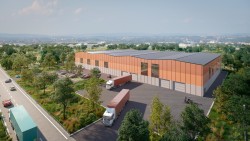The UK is running out of warehouse space, so let's grow some more,
says Sebastián Hernández Maetschl, Head of Building Concepts at Stora
Enso.
At the end of 2021, available UK warehouse space fell
below 50m ft2 for the first time since at least 2009. If that sounds
like plenty to spare, it isn't – UK businesses took up roughly that
amount from just January to September the same year. The fact is that
the pandemic accelerated an already rampant (and probably irreversible)
trend: the shift to ecommerce and consequent need for warehousing and
distribution space.
And of course – as it is 2022 – it is
important that these are built in as green a manner as possible. What to
do? New warehouses don't grow on trees, after all, but the idea isn't
as far from the truth as it might sound. A new generation of industrial
buildings are emerging that are built using engineered timber. As an
approach, massive wood construction offers the possibility of low
carbon, faster, more efficient construction to help meet the UK's
voracious demand, as well as a host of other valuable benefits that
align with the country's strategic priorities.
Low-carbon, high performance
Of course, the UK warehousing and logistics sector doesn't exist
in a vacuum. It exists against a backdrop where the government is
pushing a l ow-carbon industrial strategy, and where ESG pressures (with
an emphasis on the 'E') are factoring into investor and boardroom
agendas more than ever before – and neither warehouse tenants nor
commercial real estate developers are an exception.
In this
regard, timber industrial buildings are a long-awaited alternative for a
corner of the construction sector that has historically had no option
but to rely on carbon-intensive concrete and steel.
Timber
industrial buildings can cut embodied carbon emissions by up to 30%
versus comparable structures made with traditional materials. Too often,
the carbon conversation focuses narrowly on operational emissions when
it comes to buildings – those created through use of the building
throughout its lifecycle. Those are important, but we shouldn't lose
sight of embodied emissions, which are those inherent in the fabric and
materials of the building itself. That would be like focusing
exclusively on fuel use for your car while waving away the emissions
involved in extracting, refining and assembling 1.5 tonnes of metals and
plastics into a vehicle.
When sustainable forestry practices are
followed, wood is a completely renewable and carbon negative material.
In the cultivated forests of Northern Europe, trees are planted at a
faster rate than they are harvested, and those trees remove and trap
carbon dioxide from the air as they grow. That carbon stays locked away
when the tree is harvested and the wood turned into engineered timber
components, meaning that for the lifecycle of a wooden industrial
building, it is keeping that carbon from adding to the atmosphere. Of
course, there are other emissions involved in processing and transport,
but this means that engineered timber's overall embodied carbon
emissions are radically reduced versus materials such as steel and
concrete which create vast quantities of carbon emissions during its
production.
Timber industrial buildings are a way for developers
and warehouse tenants to improve environmental performance, both as a
goal and as a way to improve standing with shareholders, consumers and
other stakeholders.
Fast growth warehouses
In the context of warehouse space shortage, a major attraction of
timber industrial buildings is that they can be erected fast. Engineered
timber elements naturally lend themselves to prefabrication and modular
construction methods, allowing for components to largely be built
offsite. Then, once they are delivered, it is a relatively simple matter
of fitting the pieces together, which can be completed by a small,
skilled team in a short matter of weeks. Not only is the total build
time accelerated, but there is less time with active work onsite and
fewer deliveries, reducing contracting costs and disruption to the local
area. This is especially important when there are concerns about impact
on nearby residents, or if the build has to be integrated into a
broader set of local works and developments.
The design stage
also factors heavily into the total speed of the project. Not only does a
modular approach lend flexibility that allows smart developers to
accommodate external factors like adjacent developments etc, but the
speed of the design itself is important. Pre-optimised base designs
allow architects to select an appropriate specification from eight
different spans and customise for their needs. These range from 12 to
36m spans, from small workshops to large retail sheds and warehouses,
and include fully interactive 3D models and technical specifications.
Pre-optimised design plus prefabricated components make for a nigh
unbeatably rapid total project lifecycle – a handy option for developers
racing to meet runaway demand.
Bonus benefits
Though they may not be central to the final investment decision to
press ahead with a timber industrial building design, there are several
supplementary benefits that are nonetheless worth consideration. For
example, taste is subjective, but timber buildings can be strikingly
attractive compared to corrugated metal sheds. This 'soft' factor may
feature in hard business decisions if it helps secure planning
permissions and local support where space is at a premium and industrial
land abuts residential.
Studies have also shown that timber
buildings can be better for occupants' health and productivity.
Productivity rates go up by 8% according to one study, while general
wellbeing improves 13%. These benefits are already recognised and valued
for educational and office environments, but workers in the warehousing
and logistics sector are surely no less deserving or needful.
So,
no – warehouse space doesn't grow on trees. But you can turn the trees
themselves into warehouse space and there is a wealth of benefits to
doing so, from speed to sustainability to aesthetics and wellbeing. If
the UK really is running out of warehouse space, then the solution is
simple: let's grow some more.
Source: Stora Enso









